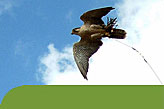

| |
Home |
| |
|
| |
About the Centre |
| |
|
| |
Our Birds |
| Falcons | |
| Hawks | |
| Buzzards | |
| Eagles | |
| Kites | |
| Vultures | |
| Owls | |
| |
|
| |
Our People |
| |
|
| |
Falconry Courses |
| |
|
| |
Links |
| |
|
| |
Injured Birds |
| Falcons There are about 35 species of falcons found in the world of which we have several at the centre. They are all closely related and come a single genus – Falco, which is latin for scimitar shaped; a shape which can be seen in the classic falcon wing shape. They are all superbly adapted for flight relying on their speed and agility to catch their prey. Speed is most dramatically demonstrated during the stoop where a falcon dives upon its prey from a great height. |
 |
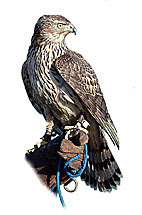 |
Hawks There are a number of hawk like birds belonging to the buzzard family of which we have three here at the centre; the Harris Hawk which is a barabuteo – or buzzard like hawk and the Ferruginous Hawk and the Red Tailed Hawk which are buteo hawks. Technically these are classified as buzzards but they are sufficiently hawk like to be given the common name hawk. |
| Buzzards Buzzards belong to the same family as the hawks and eagles and share many of the same characteristics although their broad wings are longer than their hawk counterparts allowing them to seek prey by soaring seemingly effortlessly on thermals. This makes them much more suited to hunting over open or sparsely wooded ground and they are in general less manoeuvrable than the hawks. |
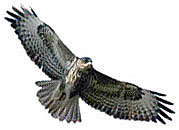 |
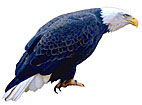 |
Eagles Eagles whilst belonging to the same family of birds as the hawks and buzzards are not themselves all directly related. The true eagles belong to the genus Aquila which is Latin for Eagles; however, the term is applied to a large variety of unrelated birds of prey. The one thing that most eagles have in common irrespective of size is their strong powerful build, large feet and heavy beak. This helps ensure that they achieve a kill when catching prey. |
| Kites Kites are exceptional amongst the birds of prey as they have an extremely light wing loading; this is where the wing area is very large in comparison to their body weight. This ability enables kites to soar and manoeuvre without any visible effort. They often even feed on the wing by passing food from their feet to their mouths. Kites as a group are highly adaptable and will often be found near human civilisation as they will scavenge whenever possible. Indeed the Red Kite was once common in large towns and cities throughout Britain before its widespread persecution in the 19th Century. |
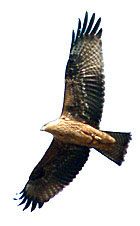 |
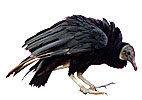 |
Vultures Common features include long broad wings and feeding upon carrion. Many vultures have bare feet, heads and necks to prevent contamination from carcasses. At the centre we have two species of New World vultures which are often found together in the wild. |
| Owls Whilst not related to the daytime or diurnal birds of prey the owls are a large group of birds which fill their niche at night or during the twilight hours of dusk and dawn. They are perfectly adapted to hunting in low light conditions. Their large eyes are set at the front of their heads giving them the best binocular vision of any birds and have a larger quantity of ‘rod’ cells than usual to enhance vision in twilight. The most striking feature of the owls is their facial disc which makes them appear very human like. The facial disc however, is a superb adaptation allowing their hearing to be amplified greatly to the point where many owls are able to hunt in complete darkness using only their hearing to pinpoint prey. Their silent flight means that they are then able to pounce in the darkness without disturbing their meal. |
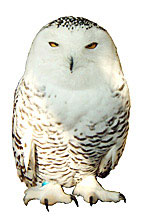 |
